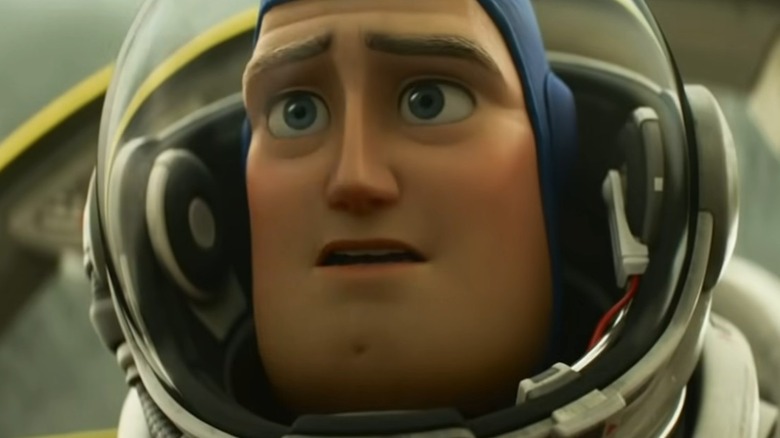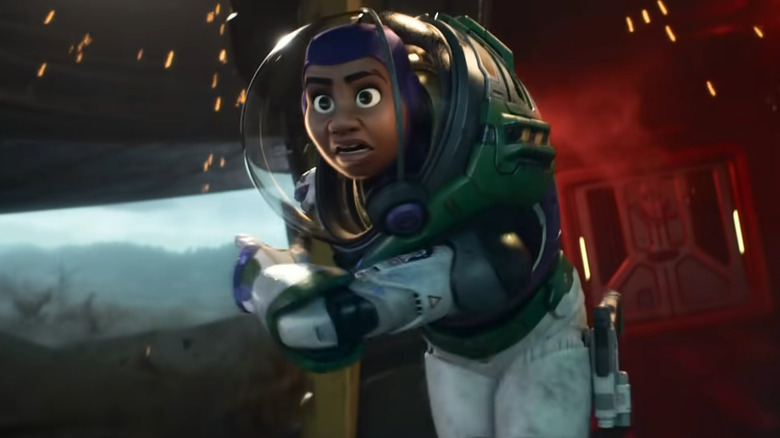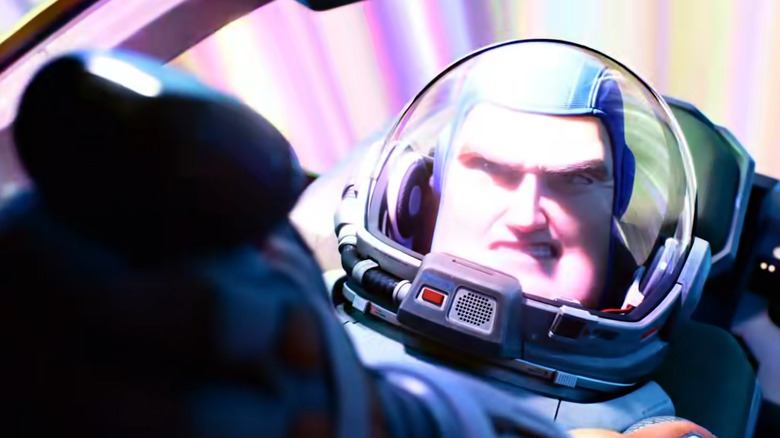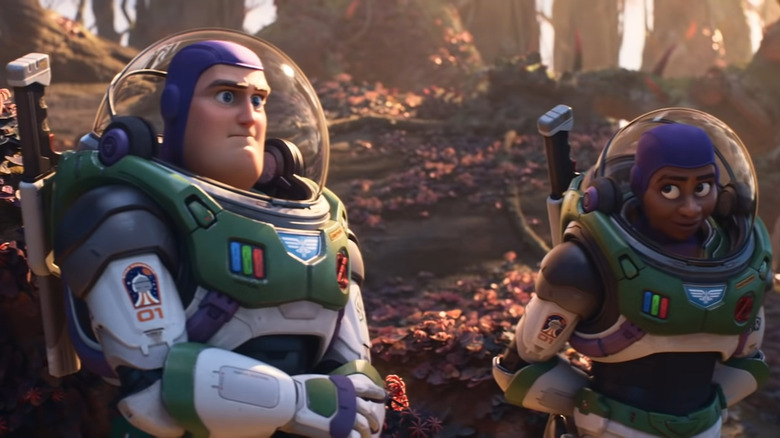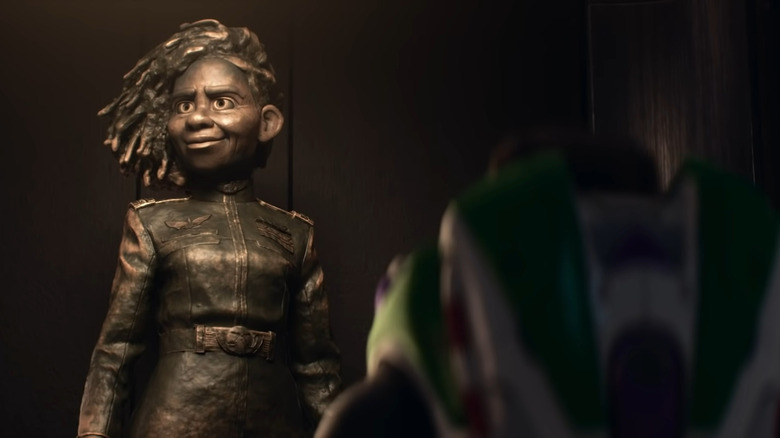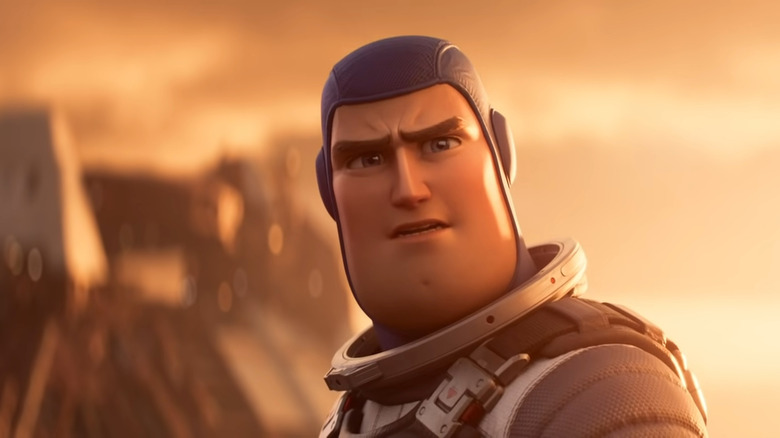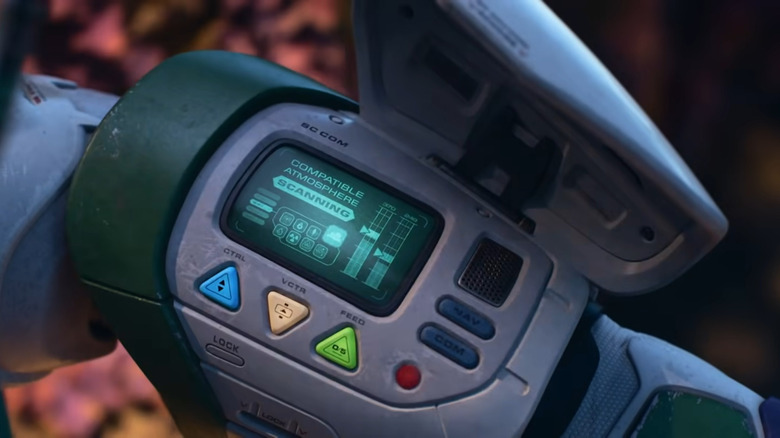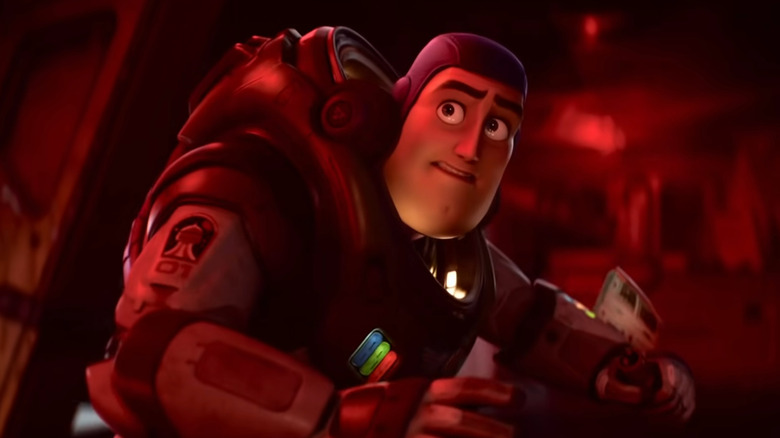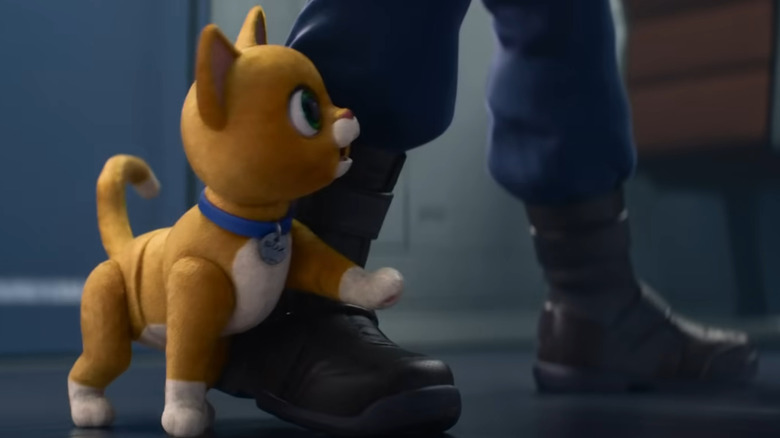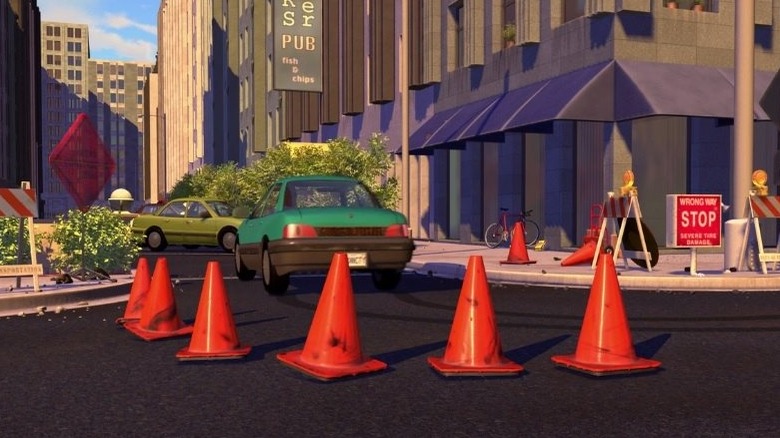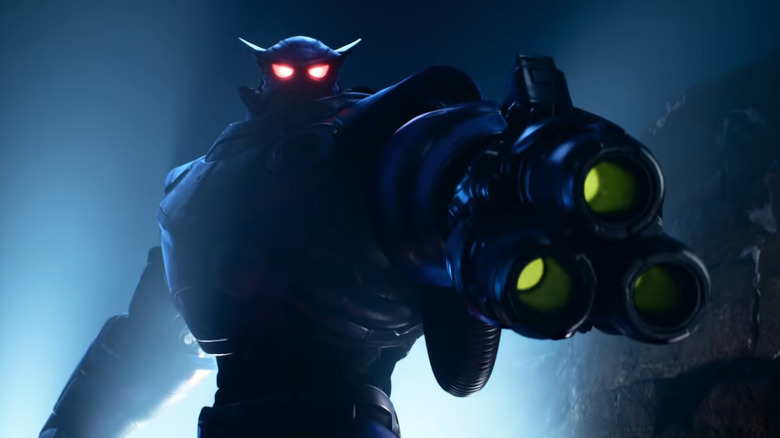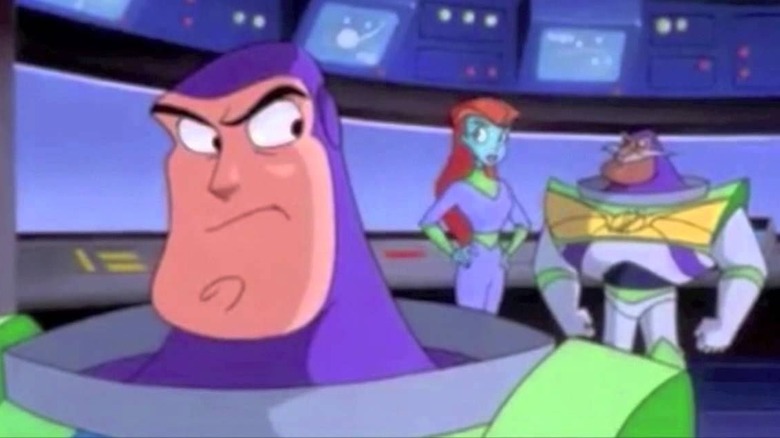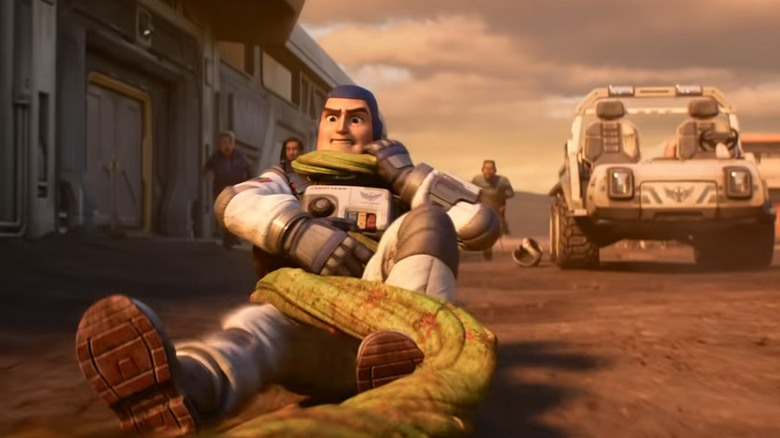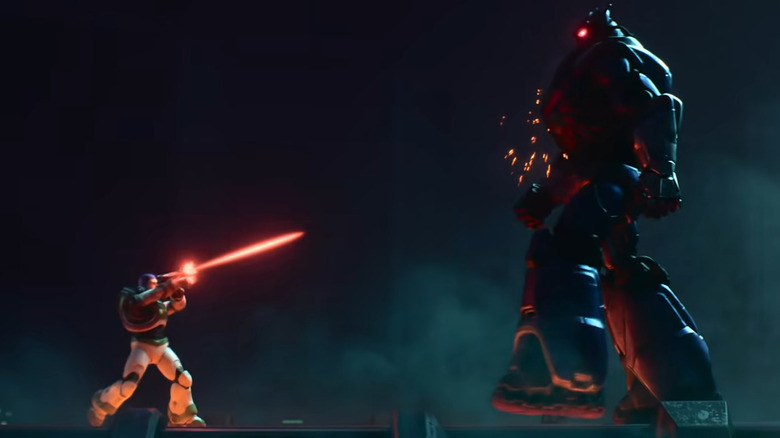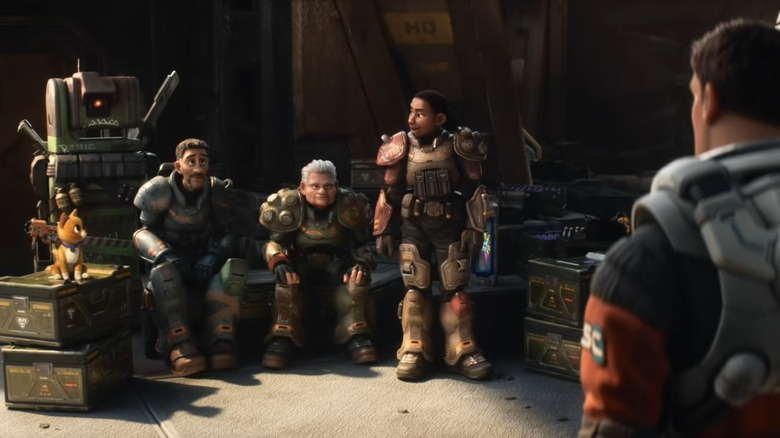Easter Eggs You Missed In Lightyear
Pixar's "Lightyear" gives you everything you never knew about the titular "Toy Story" hero — his full origin story and mythos, as told by the 1995 film that made the action figure so popular in Andy's world. Setting the movie within the canon of the "Toy Story" franchise in this way is an interesting choice, and it opens up a lot of possibilities for callbacks and tie-ins. For as many new reveals as there are in "Lightyear," and despite Chris Evans taking over the eponymous role from Tim Allen, the film still pulls heavily from its predecessors.
Make no mistake: This is still a wholly independent story. You could show up to the theater and buy a "Lightyear" ticket with no prior knowledge of Buzz as a character, and you'd probably still have a good time. The film has earned strong reviews, after all, as has become the expectation for Pixar's animated features. But without an active knowledge of the "Toy Story" lore, a lot of the little details in "Lightyear" may fly right over your head like a ship in hyperspace.
From catchphrases and design details to whole plot lines, "Lightyear" makes a lot of references to the "Toy Story" franchise. And, of course, it also has its fair share of homages to sci-fi classics of the past. Here are some Easter eggs that you might have missed in "Lightyear."
The Space Ranger suits
You can't separate Buzz Lightyear from his Space Ranger suit — quite literally in the "Toy Story" movies. Even though he gets some time out of the bubble helmet in "Lightyear," Buzz still seems the most like himself when he's geared up in the green Galactic Alliance garb. There are a couple of different iterations of the Space Ranger suit that pop up through Lightyear, with the old-school model from the beginning and the updated version in the final scenes being the two main ones. They both include a lot of little details that are pulled straight out of "Toy Story" that long-time fans will surely catch.
From the three brightly-colored buttons on Buzz's chest plate (one of which is used repeatedly to activate "stealth mode") to the wrist communicator he's constantly talking into (more than just a sticker this time around), the "lightyear" suit is a spot-on recreation of the toy. Or at least, the new model seen at the end of the movie is. The older suits have some small differences — no wrist laser and a big red button instead of a switch on the front (revealed to be the shameful "surrender button"). But by the time the credits roll, Buzz and his team have all gotten their shiny new Space ranger outfits — a design so cool that every kid in 1995 wanted to have one of their own.
Crystallic fusion
A lot of the story in "Lightyear" centers around crystallic fusion — the sci-fi method by which Star Command and its agents are able to achieve hyperspeed in their spacecrafts. When Buzz and the other inhabitants of SC-01 crash-land at the start of the film, their old fusion core is destroyed, forcing them to experiment with the resources available to them locally in the hopes of creating a new one. It's a process that takes decades, with Buzz undergoing numerous failed experiments with crystals that are just a little bit off. Finally, his robot companion Sox (Peter Sohn) comes up with the correct solution, and a fully-functional crystallic fusion core is created.
Of course, crystallic fusion has been a part of "Toy Story" lore from the very beginning. In the original film, during Buzz and Woody's very first conversation, Buzz asks his future best friend a series of questions, believing himself to have landed on an alien planet. In the hope of repairing his ship (a plot line itself that's very relevant to "Lightyear"), he asks Woody what power sources are available. "Do you people still use fossil fuels, or have you discovered crystallic fusion?" he asks Woody, who responds, baffled, "We've got double As." In the grand scheme of things, this is a tiny detail buried in a throwaway line, so it's cool to see "Lightyear" remain so loyal to the idea in its own story.
Buzz Lightyear's famous catchphrases
There are a lot of lines in "Lightyear" that are taken straight out of the "Toy Story" movies — like, a lot. Some of them will be immediately obvious to anyone familiar with the earlier movies. For instance, at the very beginning of "Lightyear" when Buzz and Alisha (Uzo Aduba) are exploring the alien planet, Buzz records a mission log commenting on the landscape, observing that the "terrain seems a bit unstable." Of course, this is also his comment when walking around on Andy's bed in the original "Toy Story."
There are bunch of these little reference lines scattered throughout "Lightyear." Classics like "I'm Buzz Lightyear, I'm always sure" and "Not today, Zurg" will stick out to those listening for them, and they add a nice texture to the film by connecting it repeatedly back to "Toy Story." It's fun to see all the little ways in which the toy Buzz pulls his personality from his fictional self, and the many catchphrases are a great way of showing that.
An Interstellar adventure
The first act of "Lightyear" is a rollercoaster, to say the absolute least. After crashing on the alien planet and setting up a colony, Buzz and Star Command begin working a new crystallic fusion core to reactive hyperspeed and get everybody off-world. Buzz flies the first test mission for the core, which is supposed to take him four minutes and 28 seconds. However, due to the temporal distortion of hyperspeed (which he doesn't quite fully reach), more than four years have passed by the time Buzz lands.
Time dilation is certainly not a new concept in the sci-fi genre. In fact, it's pretty scientific. But in the modern context of the genre, it's hard not to draw a direct comparison to Christopher Nolan's "Interstellar," which features a devastating moment of severe time dilation. Buzz's four years aren't nearly as long as the amount of time skipped in "Interstellar," but the effect is still unnerving. What's arguably even more unsettling is that Buzz continues to volunteer for more test flights, knowing full-well that he'll lose years every time. Despite that danger, he remains loyal to the mission, just as "Lightyear" remains loyal to the science fiction greats of the past.
Buzz's little quirks
Despite the fact that his voice actor, anatomy, and universe are all completely different, Buzz himself stays remarkably consistent to his "Toy Story" characterization in "Lightyear." Some of his personality traits are obvious — the need to constantly record his mission log, his wariness, and his hyper-fixation on the mission at hand. But some of the other consistencies are much smaller and easier to miss.
For instance, Buzz's resistance to teamwork, and specifically to working with anyone he deems unqualified, is very true to his portrayal in the first "Toy Story." In fact, he experiences very similar arcs in the two films, going from a moody loner to a willing member of a larger community. Buzz's general hesitation at normal social interaction and relationship-building is also something that's kept the same from "Toy Story," as the character is always more focused on his mission in both instances. By keeping all these little personality touches the same, Pixar pulls off an impressive balancing act — creating a version of the character who feels new, while at the same time being a continuation of what's been established in the past.
Retro space tech
The opening of "Lightyear" says that it was released in 1995 in the "Toy Story" timeline. While it would have been easy for the film to completely ignore that detail later on, it remains an active component of the overarching style. A lot of the movie takes inspiration from even older sci-fi franchises like "Buck Rogers" (giant bugs, laser shields, ray guns, etc.), but there are a number of details that feel specifically '90s in nature.
During Buzz's first hyperspeed test flight, for example, his autopilot system I.V.A.N. starts malfunctioning. Buzz pulls I.V.A.N. out of the ship's system, revealing it to be nothing more than a blocky plug-in, and blows into it like it's an NES cartridge. Sure, enough the autopilot immediately starts to work as intended.
This isn't the only '90s detail that comes up, either. Many of the digital readouts in "Lightyear" have the blocky overlays of '90s computer screens, which makes sense for a movie that's supposed to have been released in 1995. Obviously, "Lightyear" pulls from all eras of science fiction, and it still feels like a contemporary animated movie in its overall structure. But still, it's fun to see that the writers committed to the mid-1990s setting in multiple ways.
2001: A Buzz Odyssey
When you make a big-budget science fiction movie, it's only right that you pay homage to the greats of the genre. "Lightyear" takes that obligation quite seriously, and one of it's most clever sci-fi references is to none other than Stanley Kubrick's "2001: A Space Odyssey." At this point, that film's famous "Open the pod bay doors, HAL" scene has been spoofed countless times, but that doesn't stop "Lightyear" from doing its own spin on the line.
After things go wrong on his first hyperspeed test flight, Buzz frantically tries to get his ship back to the ground in one piece. Unfortunately, his autopilot I.V.A.N. is more of a hindrance than a help. In a fit of frustration, Buzz shouts the order, "Open the fuel door, I.V.A.N." The computer responds, "I'm sorry, I didn't quite catch that" — a clear parody of HAL's icy "I'm sorry Dave, I'm afraid I can't do that." Not only is this a sneaky reference to "2001," but it's also a joke about how Siri and other real-world voice-command and navigation systems often mishear things. In this way, the joke works both for those who might not get the Kubrick homage — like Pixar's young target demographic — and for those who recognize HAL's line.
Curiously, this isn't the first time that Buzz Lightyear has been part of a "2001" Easter egg. In the opening sequence of "Toy Story 2," which is set in a video game starring the Space Ranger, the film's iconic theme music is played via a series of floating platforms. Clearly, someone at Pixar has a lot of love for "2001."
R2-Sox2
It's no secret that Pixar loves spoofing "Star Wars" in its Buzz Lightyear storylines. Zurg is basically a big, silly, purple Darth Vader with Emperor Palpatine's title. And if you thought that "Lightyear," would mark the end of Buzz's history of "Star Wars" references, you'd be very wrong.
The big one in "Lightyear" is more subtle than some of the ones in the "Toy Stoy" films, but it should still stick out to those who know both series well. Sox, Buzz's robotic cat comrade, is able to interface with various computer systems using a plug in the tip of his tail. When he interfaces and starts "hacking," his head spins around in full 360 degrees and he starts mumbling "beep boop beep boop" over and over again. It's a funny gag, if a pretty simple one, and it seems like a pretty clear reference to R2-D2's own hacking habits in "Star Wars."
While R2 certainly isn't the only prominent sci-fi robot to hack into computer systems, the specific way in which Sox goes about his work and the sounds he hilariously makes are strikingly similar to the astromech droid in particular. It seems that every galactic hero needs a robot companion with a USB cable.
Capture cones or traffic cones?
This one's pretty specific, but it also stands out if you're looking for it.
Midway through "Lightyear," Buzz and the gang infiltrate an old mining station to get a necessary computer part for their ship. However, they accidentally trip the outpost's security system, and are subsequently trapped in bright orange "capture cones." That's right — Buzz lightyear gets stuck under a bright orange cone with his friends and has to figure his way out of a potentially dangerous situation. Ringing any bells?
Of course, we're referring to the iconic street-crossing scene in "Toy Story 2," which sees Buzz, Rex, Ham, and the rest of the crew hide under traffic cones in order to cross a busy road. While the circumstances surrounding the two scenes are quite different, the orange color and conical structure of the "capture cones" are just too similar for them not to be an intentional reference.
Zurg tech
If you've absorbed much Buzz Lightyear content in the past, you'll recognize a number of the visual touches surrounding Zurg and his robots in "Lightyear." The robots themselves are a little more advanced and intimidating than the ones seen in "Toy Story 2," but they still have the same basic design. The same is true for Zurg himself, who swaps out his old robe and cape for a more mechanical aesthetic but still remains unmistakably him.
From the giant robot mouth and the little bull horns to the tri-barreled ion blaster, Zurg retains almost all of his most memorable touches. And, of course, every last bit of Zurg tech bears the villain's purple color palette. Even Zurg's dreadnought harkens back to the franchise's past, although it does looks a good deal different this time around. Still, "Lightyear" isn't the first official Buzz Lightyear story to show the evil emperor's intimidating flagship.
The original Buzz Lightyear movie
Some people may have forgotten, but "Lightyear" isn't the first time that Buzz has gotten a spinoff that explores his sci-fi lore and backstory. In 2000, the direct-to-video movie "Buzz Lightyear of Star Command: The Adventure Begins" kicked off a short-lived cartoon set in the Space Ranger universe. And while that lesser-known Buzz Lightyear movie doesn't seem to be canon anymore, it does bear some striking similarities to Pixar's newer film.
Both movies involve Buzz learning to accept help from a ragtag group of unlikely heroes who want desperately to be Space Rangers. In the older film, the team is comprised of a robot named XR, a former Star Command janitor named Booster, and recent recruit and princess Mira Nova. Like in "Lightyear," Buzz repeatedly expresses his distaste for rookies, but he eventually comes around on the group, and together they stop Zurg's evil plan. Sound familiar?
There are some other similarities between the two movies, such as the presence of an experimental spacecraft that our heroes must steal against their superiors wishes. In the older film, that ship is called the Alpha-One, while in "Lightyear" it's called the XL-01. There are plenty of differences as well, like the lack of little green men in "Lightyear" and the change in Zurg's backstory, but the two are a lot more similar than you might think for two films released 22 years apart.
Buzz's special abilities
As the "Toy Story" movies constantly remind us, Buzz Lightyear is a cool toy. He comes with "karate-chop action," a wrist-mounted laser, and a winged jetpack (though he's not a flying toy). All of these special abilities come into play in "Lightyear" as well, with some proving crucial.
At multiple points throughout the film, Buzz shows off his "karate-chop action," which manifests as a far more versatile collection of martial arts skills. His wrist laser doesn't come with the old Space ranger suit model, but in the third act of the film, Buzz improvises by strapping a smaller standalone laser blaster to his wrist for easy use. The weapon comes in particular handy in his battle with Zurg, and when the new Space Ranger suits are revealed at the end of the film, they all have wrist lasers built in.
As for Buzz's winged jetpack, Pixar waits most of the movie to reveal it. Only when the rest of th team is reentering the atmosphere in their ship does Buzz pop the wings to try to help keep the vessel on course. It all works out, though the reentry could definitely be classified as falling with style.
The Zurg battle
"Lightyear" wouldn't be complete without a proper battle between Buzz and Zurg, and that's exactly what the film delivers in its third act. The two go head-to-head in a heated fight that spans Zurg's dreadnought and even extends to the open space beneath it, with Buzz ultimately coming out victorious.
While not a carbon-copy, the "Lightyear" fight does have some similarities to the Zurg battles in the "Toy Story" movies. For instance, the shot where Buzz jumps and front-flips over Zurg, then turns to quickly fire a laser back, is taken right out of the Buzz Lightyear video game Rex plays at the beginning of "Toy Story 2." Fortunately, the real Buzz has better luck than Rex.
And, of course, the last round of the rivals' duel in "Lightyear" — which takes place in the void of space — features a classic exchange between the two. Zurg orders Buzz to "Prepare to die," and Buzz retorts, "Not today, Zurg!" We all knew it was coming, but it's still fun to hear.
The Gamma Quadrant of Sector 4
The ending of "Lightyear" foreshadows a bright future for Buzz, his friends, and the Galactic Alliance. The Space Ranger Corps is reinstated with state-of-the-art tech, and Buzz's team becomes officially sanctioned for high-priority missions. Their first assignment? Head to the Gamma Quadrant of Sector 4 for some investigating. That destination may ring familiar if you're up on "Toy Story."
When Buzz first arrives in Andy's room, he says that he's stationed in the Gamma Quadrant of Sector 4. The location is mentioned again in "Toy Story 2," as it's the setting of Buzz's video game battle with Zurg. Given that the evil emperor is shown to still be alive at the end of "Lightyear," it's possible that a new version of that showdown could take place in a sequel. Either way, it'd nice to see Pixar staying so consistent with the silly lore they've created over the decades. Since the Buzz toy has all the memories of his fictional self, it makes sense that he'd have a strong association with the Gamma Quadrant of Sector 4.
